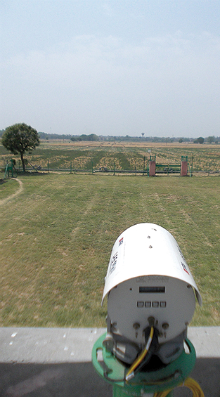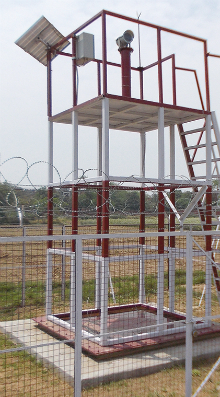A large aperture scintillometer (LAS) is an open-path optical device for monitoring fluctuations in refractive index of the turbulent atmosphere. The infrared light beam is transmitted to the receiver over path lengths up to 4.5 km that represent a relatively large area.
The LAS MkII receiver can calculate the real-time sensible heat flux (H) with the accessory meteorological sensor kit. The data can be stored in its internal memory. When combined with net radiation (NR Lite2) and other meteorological data, the spatially averaged evapotranspiration (ET) can be derived by the Kipp & Zonen EVATION software package.
 LAS MkII receiver
LAS MkII receiver
The surface heat fluxes measured by the LAS are linked to latent heat flux (LvE) and evapotranspiration (ET), and can contribute to energy balance and water balance studies. Compared to traditional point measurement systems, the LAS MkII operates at spatial scales comparable to the grid box size of numerical models and the pixel size of satellite images used in meteorology, hydrology and water management studies.
The LAS MkII has been installed at the agricultural experimental farm of the Indian Agricultural Research Institute in New Delhi. The path length is 990 m over an irrigated and cultivated agricultural landscape. The paper discusses the patterns of energy flux on diurnal and seasonal bases at the scintillometer path. The area was mainly covered by maize in the Kharif (monsoon crop) and wheat in the Rabi (winter) season during the crop growing seasons of 2014-2015.
The biophysical parameters (leaf area, soil moisture, crop height) were recorded at a two-weekly temporal resolution along the path length, at regular sampling distances. The Bowen ratio value for Kharif and Rabi seasons was 0.76 and 0.88 respectively for the scintillometer. Leaf area index had a significantly positive correlation with latent heat flux (R2 = 0.80) while a significantly negative correlation with sensible heat flux (R2 = -0.79). Soil moisture had a significant negative correlation with sensible heat flux (R2 = -0.68).
The average evapotranspiration from cropland was 1.58 mm of water depth per day and total evapotranspiration was 543 mm over the twelve months study period, most of this falling during the monsoon period (July to September).
 Solar powered LAS MkII transmitter
Solar powered LAS MkII transmitter
This study shows that the LAS MkII is a robust instrument, which can evaluate energy flux over a large area, and for long periods. Further studies could lead to use in crop simulation modelling, development of new models with calibration by LAS, validation of remote sensing energy balance algorithms, and the optimum utilization of water for irrigation.
Experiments with LAS over large and relatively homogeneous agroecosystems are critical for accurate and large-area representative measurements of ET, and also useful in the calibration and validation programmes of polar and geostationary satellite instruments. Additionally, it can be used in development of crop simulation models, new remote sensing energy balance algorithms, and their calibration and validation.
LAS has a major advantage to evaluate remote sensing flux with large spatial coverage that is more reliable, considering the satellite pixel sizes, than other flux estimation methods like Lysimetry or Eddy Covariance.
For more information, visit the Division of Agricultural Physics at: bit.ly/2nTPIXC
The paper is available from: bit.ly/2AfEFcO
Article by Vinay Sehgal, Professor & Principal Scientist, Division of Agricultural Physics, Indian Agricultural Research Institute, New Delhi & Keith Wilson, Atmospheric Scientist, Kipp & Zonen
(1) Citation: Abhishek Danodia, Vinay Kumar Sehgal, N.R. Patel, Rajkumar Dhakar, Joydeep Mukherjee, S.K. Saha and Senthil Kumar (2017). Assessment of Large Aperture
Scintillometry for large-area surface energy fluxes over an irrigated cropland in North India. Journal of Earth System Science. 126. 13. 10.1007/s12040-017-0847-6.